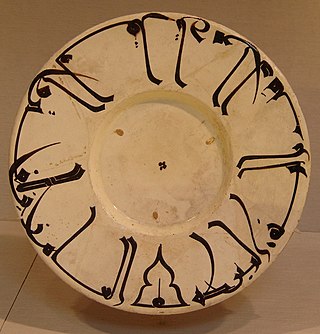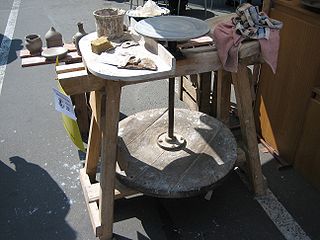
Pottery is the process and the products of forming vessels and other objects with clay and other raw materials, which are fired at high temperatures to give them a hard and durable form. The place where such wares are made by a potter is also called a pottery. The definition of pottery, used by the ASTM International, is "all fired ceramic wares that contain clay when formed, except technical, structural, and refractory products". End applications include tableware, decorative ware, sanitary ware, and in technology and industry such as electrical insulators and laboratory ware. In art history and archaeology, especially of ancient and prehistoric periods, pottery often means only vessels, and sculpted figurines of the same material are called terracottas.

Flint, occasionally flintstone, is a sedimentary cryptocrystalline form of the mineral quartz, categorized as the variety of chert that occurs in chalk or marly limestone. Historically, flint was widely used to make stone tools and start fires.

Earthenware is glazed or unglazed nonvitreous pottery that has normally been fired below 1,200 °C (2,190 °F). Basic earthenware, often called terracotta, absorbs liquids such as water. However, earthenware can be made impervious to liquids by coating it with a ceramic glaze, and such a process is used for the great majority of modern domestic earthenware. The main other important types of pottery are porcelain, bone china, and stoneware, all fired at high enough temperatures to vitrify. End applications include tableware and decorative ware such as figurines.

Pottery and porcelain is one of the oldest Japanese crafts and art forms, dating back to the Neolithic period. Types have included earthenware, pottery, stoneware, porcelain, and blue-and-white ware. Japan has an exceptionally long and successful history of ceramic production. Earthenwares were made as early as the Jōmon period, giving Japan one of the oldest ceramic traditions in the world. Japan is further distinguished by the unusual esteem that ceramics hold within its artistic tradition, owing to the enduring popularity of the tea ceremony. During the Azuchi-Momoyama period (1573-1603), kilns throughout Japan produced ceramics with unconventional designs. In the early Edo period, the production of porcelain commenced in the Hizen-Arita region of Kyushu, employing techniques imported from Korea. These porcelain works became known as Imari wares, named after the port of Imari from which they were exported to various markets, including Europe.

In pottery, a potter's wheel is a machine used in the shaping of clay into round ceramic ware. The wheel may also be used during the process of trimming excess clay from leather-hard dried ware that is stiff but malleable, and for applying incised decoration or rings of colour. Use of the potter's wheel became widespread throughout the Old World but was unknown in the Pre-Columbian New World, where pottery was handmade by methods that included coiling and beating.

Ceramics of Indigenous peoples of the Americas is an art form with at least a 7500-year history in the Americas. Pottery is fired ceramics with clay as a component. Ceramics are used for utilitarian cooking vessels, serving and storage vessels, pipes, funerary urns, censers, musical instruments, ceremonial items, masks, toys, sculptures, and a myriad of other art forms.

A saggar is a type of kiln furniture. It is a ceramic boxlike container used in the firing of pottery to enclose or protect ware being fired inside a kiln. The name may be a contraction of the word safeguard.

Korean ceramic history begins with the oldest earthenware from around 8000 BC. Throughout the history, the Korean peninsula has been home to lively, innovative, and sophisticated art making. Long periods of stability have allowed for the establishment of spiritual traditions, and artisan technologies specific to the region. Korean ceramics in Neolithic period have a unique geometric patterns of sunshine, or it is decorated with twists. In Southern part of Korea, Mumun pottery were popular. Mumun togi used specific minerals to make colors of red and black. Korean pottery developed a distinct style of its own, with its own shapes, such as the moon jar or Buncheong sagi which is a new form between earthenware and porcelain, white clay inlay celadon of Goryeo, and later styles like minimalism that represents Korean Joseon philosophers' idea. Many talented Korean potters were captured and brought to Japan during the invasions of Korea, where they heavily contributed to advancing Japanese pottery. Arita ware, founded by Yi Sam-pyeong opened a new era of porcelain in Japan. Another Japanese representative porcelain, Satsuma ware was also founded by Dang-gil Shim and Pyeong-ui Park. 14th generation of Su-kwan Shim have been using the same name to his grandfather and father to honor they are originally Korean, 14th Su-kwan Shim is honorable citizen of Namwon, Korea.

Sgraffito is an artistic or decorative technique of scratching through a coating on a hard surface to reveal parts of another underlying coating which is in a contrasting colour. It is produced on walls by applying layers of plaster tinted in contrasting colours to a moistened surface, and on pottery by applying two successive layers of contrasting slip or glaze to an unfired ceramic body. The Italian past participle sgraffiato is also used for this technique, especially in reference to pottery.

The history of art stretches back centuries to ancient times, but the most famous period is undoubtedly the Khmer art of the Khmer Empire (802–1431), especially in the area around Angkor and the 12th-century temple-complex of Angkor Wat, initially Hindu and subsequently Buddhist. After the collapse of the empire, these and other sites were abandoned and overgrown, allowing much of the era's stone carving and architecture to survive to the present day. Traditional Cambodian arts and crafts include textiles, non-textile weaving, silversmithing, stone carving, lacquerware, ceramics, wat murals, and kite-making.

Montelupo Fiorentino is a comune (municipality) in the Metropolitan City of Florence in the Italian region of Tuscany, located about 20 kilometres southwest of Florence.

Mishima ware (三島焼) refers to different types of imported and adopted Japanese pottery. Mishima originally refers to the shimamono pottery imported from the islands of Taiwan, Luzon, and "Amakawa" (Macau). They were characterized by being roughly-made and often uneven, thus epitomizing the Japanese aesthetic of wabi-sabi. In later centuries, it came to refer to imported ceramics (Gohon) from Korea with the slip inlay style. This style was imitated and produced locally in Japan.

Goryeo ware refers to all types of Korean pottery and porcelain produced during the Goryeo dynasty, from 918 to 1392, but most often refers to celadon (greenware).

Cizhou ware or Tz'u-chou ware is a wide range of Chinese ceramics from between the late Tang dynasty and the early Ming dynasty, but especially associated with the Northern Song to Yuan period in the 11–14th century. It has been increasingly realized that a very large number of sites in northern China produced these wares, and their decoration is very variable, but most characteristically uses black and white, in a variety of techniques. For this reason Cizhou-type is often preferred as a general term. All are stoneware in Western terms, and "high-fired" or porcelain in Chinese terms. They were less high-status than other types such as celadons and Jun ware, and are regarded as "popular", though many are finely and carefully decorated.
The pottery of ancient Cyprus starts during the Neolithic period. Throughout the ages, Cypriot ceramics demonstrate many connections with cultures from around the Mediterranean. During the Early and Middle Bronze Ages, it is especially imaginative in shape and decoration. There are also many early terracotta figurines that were produced depicting female figures.

Persian pottery or Iranian pottery is the pottery made by the artists of Persia (Iran) and its history goes back to early Neolithic Age. Agriculture gave rise to the baking of clay, and the making of utensils by the people of Iran. Through the centuries, Persian potters have responded to the demands and changes brought by political turmoil by adopting and refining newly introduced forms and blending them into their own culture. This innovative attitude has survived through time and influenced many other cultures around the world.

Ceramic art is art made from ceramic materials, including clay. It may take varied forms, including artistic pottery, including tableware, tiles, figurines and other sculpture. As one of the plastic arts, ceramic art is a visual art. While some ceramics are considered fine art, such as pottery or sculpture, most are considered to be decorative, industrial or applied art objects. Ceramic art can be created by one person or by a group, in a pottery or a ceramic factory with a group designing and manufacturing the artware.

Jalisco handcrafts and folk art are noted among Mexican handcraft traditions. The state is one of the main producers of handcrafts, which are noted for quality. The main handcraft tradition is ceramics, which has produced a number of known ceramicists, including Jorge Wilmot, who introduced high fire work into the state. In addition to ceramics, the state also makes blown glass, textiles, wood furniture including the equipal chair, baskets, metal items, piteado and Huichol art.

The Kastel Fortress is a fortress located in Banja Luka, Bosnia and Herzegovina. The fortress is medieval but is situated on the site of previous fortifications going back to Roman and even pre-Roman times. It was captured by the Ottoman Empire in 1527. The fortress is relatively well-preserved, and is one of Banja Luka's main attractions, situated on the left bank of the Vrbas river in the very center of town.

Tsuboya ware is a type of Ryukyuan pottery traditionally produced in Tsuboya, a pottery district in the city of Naha, in the prefecture Okinawa. Okinawan craftsmen began engaging in this form of pottery in 1682, and have since passed down the craft for generations. The most notable feature of this ware is its enamel decoration, unique to Okinawa. Originally, ceramics produced in this style were used primarily by common, middle-class people. However, during the Taisho period (1912-1926), the style was popularized by folk art proponents like Muneyoshi Yanagi. Tsuboya ware is categorized into two types: arayachi and jōyachi. While arayachi is a more simple style and takes the form of vessels for water or alcohol, jōyachi can be recognized by its rich enamel decoration.


















